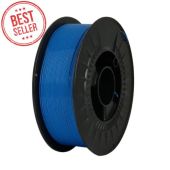PETG Print Settings: A Professional Overview for Reliable Results
PETG is a common filament choice among professionals due to its durability, chemical resistance, and ease of processing. It combines the toughness of ABS with the user-friendliness of PLA, offering reliable performance across a range of industrial and engineering applications. To achieve consistent print quality, however, PETG requires precise tuning of print parameters.
Getting optimal results depends not just on printer hardware or slicer defaults but on understanding the material’s behavior during extrusion and cooling. This guide breaks down the essential PETG print settings and variables that influence print quality in a professional environment.
Material Characteristics of PETG
PETG (Polyethylene Terephthalate Glycol) offers several advantages that make it well-suited for applications in automotive, aerospace, and electronic component production. It exhibits:
- Low shrinkage
- Excellent layer adhesion
- Glossy finish
- Impact resistance better than PLA
Professionals choose PETG for cases where mechanical strength, slight flexibility, and environmental resistance are required. It also performs well in:
- Enclosures
- Custom brackets
- Functional parts
- Food-grade components (depending on formulation)
Core PETG Print Settings
Correct print settings are essential to reduce common issues like stringing, poor adhesion, or dimensional inaccuracies. Professionals typically use the following baseline settings:
- Nozzle temperature: 230–250°C
- Bed temperature: 70–90°C
- Print speed: 40–60 mm/s
- Layer height: 0.1–0.3 mm
- Retraction: 4–6 mm (direct drive), 5–7 mm (Bowden)
- Retraction speed: 25–45 mm/s
- Cooling fan: Off or limited (<50%)
- Surface: PEI, textured sheets, or glue-treated glass
Adjustments may be needed depending on printer type, part geometry, or ambient temperature. PETG tends to over-adhere to some print beds and can suffer from stringing when retraction settings are not fine-tuned.
Key Factors to Control
To minimize failed prints and improve consistency, control these aspects:
- Temperature stability across the nozzle and bed
- Proper first layer height and extrusion width
- Flow rate calibration, typically reduced to 95–98%
- Clean extrusion path and dry filament storage
- Minimized air drafts in the print environment
Maintaining uniform layer bonding without overheating is a balancing act that requires testing and machine-specific tuning.
Application-Specific Performance
In demanding industrial scenarios, PETG performance is affected by more than just slicer settings. The printing environment and post-processing decisions play a major role in final part quality.
Using enclosed printers helps maintain consistent chamber temperatures, especially for larger parts that take several hours to print. Strategic orientation of parts on the build plate, combined with appropriate support structures, improves mechanical integrity and reduces surface cleanup.
Professionals often refine surface finish through sanding or light chemical smoothing where application and safety allow it.
Long-Term Consistency & Maintenance
Professional printing workflows require regular checks and upkeep. Even with optimal PETG print settings, poor machine condition leads to inconsistent output or failed prints.
- Nozzles must be kept clean to avoid carbonized buildup from PETG
- Z-offset and bed leveling should be checked before each job
- Filament must be stored in a sealed container with desiccant
- Worn Bowden tubes or hotends should be replaced promptly
Neglecting routine maintenance can lead to under-extrusion, warping, or nozzle jams—issues that impact both quality and production schedules.
Professional Tips for High-Precision Prints
Experienced professionals working with PETG tend to apply these best practices:
- Use slower perimeter speeds (20–30 mm/s) for tight tolerances
- Run temperature calibration towers to fine-tune each batch of filament
- Enable coasting or wipe features in slicers to reduce stringing
- Lower fan speeds for thicker layers to promote layer bonding
- Test bridging performance to optimize cooling and travel settings
PETG requires more dialing in than PLA but rewards that effort with higher-quality functional prints.
Why Print Settings Matter with 3D Trček Materials
3D Trček's PETG filaments are engineered for consistent performance. With over 500,000 filament rolls produced and more than a decade of filament R&D, their materials are trusted by professionals in Slovenia and globally.
Engineers, designers, and manufacturers across various industries rely on 3D Trček PETG for critical applications such as:
- Automotive prototyping
- Aerospace-grade lightweight parts
- Custom enclosures for electronics
- Educational and research-grade prints
Consistent filament diameter, moisture control during production, and tight tolerances ensure that the material performs predictably with properly tuned machines.
Reliable Output Depends on Optimized Input
PETG offers high value to professional users, but it demands precise control over printing variables. Start with proven baseline PETG print settings, refine them for your specific setup, and control external factors like ambient temperature and material dryness.
When used with engineered materials such as those from 3D Trček, PETG can deliver exceptional repeatability and mechanical reliability across demanding use cases.
; ?>) Shop PETG Filament
Shop PETG Filament 


Please complete your information below to login.
Prijava
Kreiraj novi račun